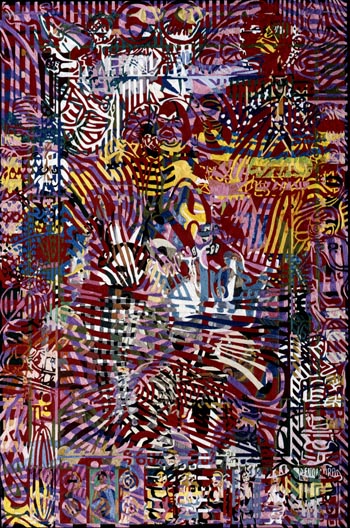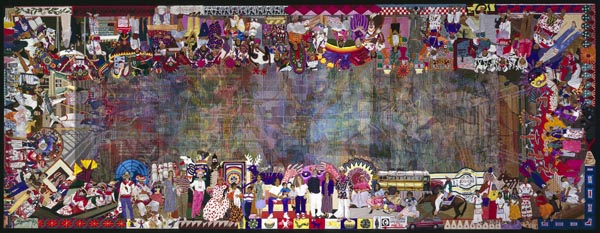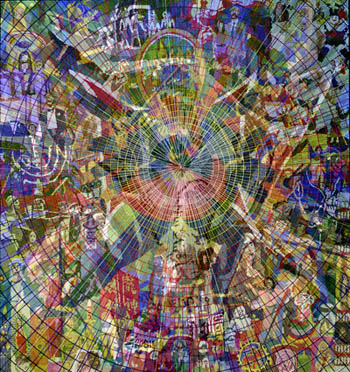January 12 - February 28, 2007
Anxiety, 2004
Yarn and glue on board, 36 x 24 inches
Birth, 2001
Yarn and glue on board, 36 x 24 inches
Spanish Lessons, 2003
Yarn and glue on board, 24 x36 inches
Huipil, 1997
Yarn and glue on board, 64 x 25 inches
Journey, 1996
Yarn and glue on board, 84x 32 inches
Driving, 2005
Yarn and glue on board, 56 x 16 inches
Frame Shop, 2003
Yarn and glue on board, 30 x 18 inches
Vision, 2002
Yarn and glue on board, 34 x 32 inches
“Mesmerizing, hypnotic and intricately crafted,” were words chosen by a reviewer to describe the work of Robert Forman. Indeed, anyone who has actually seen the work would have to agree, for it is virtually impossible to comprehend in all of its complexities through a casual viewing. The technique he uses—gluing thin segments of thread to the surface of a panel—invariably draws viewers close to the surface of his work, as if attracted by some mysterious aesthetic magnet. Once there, they are immediately drawn into a complex overlay of images that slowly but surely reveal themselves to each viewer individually, and the sense of discovery that occurs is simply spellbinding. The same writer quoted above offered the following challenge to any viewer: “Just try to stop looking at his thread paintings; it is virtually impossible.”
“Robert Forman”—the artist’s first major showing in a New York gallery—opens at Francis M. Naumann Fine Art on January 12, 2007.
Forman refers to these works as “thread paintings,” for although they are not made with pigment, they often assimilate the appearance of oil paintings. At times the work is deftly realistic—as in his depiction of light streaming into the window of a frame shop, or the view of a darkened train tunnel—but others are composed with such a dense interplay of imagery that they appear entirely abstract, that is, until they are examined more carefully. Each work in this latter style is preceded by a series of “cartoons” (a Renaissance term that applies to preparatory drawings made the same size as the final image, from which the artist works directly), a number of which will be on display in the back room of the exhibition space. It is here that Forman’s approach is most effectively revealed, for these cartoons—executed on the surface of large sheets of paper—are used as templates, transferring images that are composed of layer-upon-layer of different, though always related subjects, so that the final product is a compressed visual amalgam of the individual cartoon images. The only historical precedent that comes to mind are the transparencies of Francis Picabia, although the technique Forman utilizes causes his pictures to take on an entirely different appearance.
Indeed, for years, Forman was under the impression that his use of thread was unique, that is, until walking through Greenwich Village one afternoon he chanced upon an object made entirely with yarn imbedded into wax. Inquiring further, he learned that there were other pieces like it, and that they were made by the Huichol Indians of northern Mexico. In the early 1990s, Forman received a Fulbright Fellowship to travel to their villages in the Sierra Madre Mountains, where he discovered that yarn painting was a highly developed folk tradition among the native people there. He has since maintained close ties with the Huichol, many of whom have accepted him as a kindred spirit. Almost immediately, their rich culture and complex belief systems (they use peyote in ritualistic ceremonies to achieve ecstatic states when communicating with their gods) found their way into the visual vocabulary of Forman’s work, enriching it, few would argue, in dramatically new and exciting ways.









